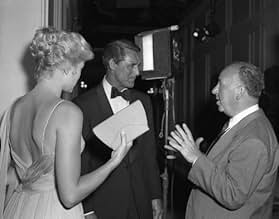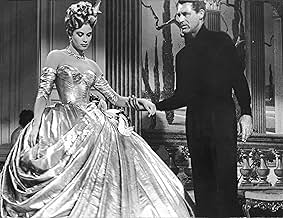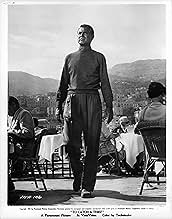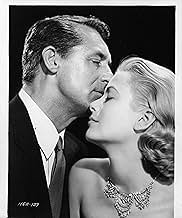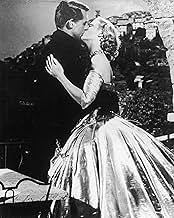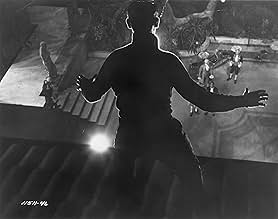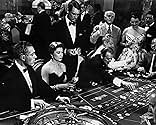Un voleur de bijoux à la retraite cherche à prouver son innocence après avoir été soupçonné de vol.Un voleur de bijoux à la retraite cherche à prouver son innocence après avoir été soupçonné de vol.Un voleur de bijoux à la retraite cherche à prouver son innocence après avoir été soupçonné de vol.
- Director
- Writers
- Stars
- A remporté 1 oscar
- 1 victoire et 5 nominations au total
George Adrian
- Detective
- (uncredited)
John Alderson
- Detective at the Costume Ball
- (uncredited)
Martha Bamattre
- Kitchen Helper
- (uncredited)
René Blancard
- Commissaire Lepic
- (uncredited)
Eugene Borden
- French Waiter
- (uncredited)
Nina Borget
- Frenchwoman
- (uncredited)
George Boyce
- Party Guest
- (uncredited)
John Breen
- Party Guest
- (uncredited)
Margaret Brewster
- Cold-cream Woman
- (uncredited)
Ralph Brooks
- Casino Patron
- (uncredited)
Sommaire
Reviewers say 'To Catch a Thief' is celebrated for its cinematography, vibrant colors, and picturesque French Riviera locations. Cary Grant and Grace Kelly's chemistry and performances are highly praised. However, some find the plot less engaging and the suspense lacking compared to other Hitchcock films. The lighter tone and romantic elements receive mixed opinions, while the beautiful costumes and set designs are standout features.
Avis en vedette
Like most of Hitchcock this is a film that withstands repeated viewings. A light crime farce it is nevertheless full of great Hitchcock touches- a particular favorite of mine is the chase through the flower market with Cary Grant's comic encounter with the old flower seller. Grace Kelly was perhaps the sexiest of all movie stars in that she could combine the glamor of a Katherine Hepburn or Elizabeth Taylor with the earthy sexiness of Marilyn Monroe. Witness her first surprise kiss with Cary Grant and his reaction. This is priceless acting and one of the reasons Grant is considered one of the greatest actors in movie history. John Williams is also excellent as the very British insurance agent and Jesse Royce Landis (who played Grant's mother in North by Northwest ) is also on hand for a number of fine moments. Although slim in terms of drama this has to rank among the top ten of Hitch's films.
When a number of jewel thefts take place on the French Riviera, suspicion falls on John Robie, an American expatriate. Robie was at one time a notorious jewel thief, but escaped from prison during the Second World War and joined the French Resistance. As a result of his bravery, he was paroled, and, although he now claims to be living an honest existence, the recent burglaries have all the hallmarks of his style. Robie has to clear his name of suspicion and expose the real "Cat", as the press have nicknamed the burglar. (The theme of a man unjustly accused or suspected of a crime was a common one with Hitchcock). Along the way, he finds time to flirt with Danielle, the attractive daughter of a local waiter, and to carry on a more serious romance with Frances Stephens, a glamorous American oil heiress.
Hitchcock is not, perhaps, a director whom one would normally associate with visual beauty, but as another reviewer has pointed out, this is perhaps his most visually beautiful film, with plenty of tourist-brochure shots of the Riviera. (The film won an Oscar for "Best Cinematography" and was nominated for two others, "Best Art Direction" and "Best Costume Design"). For the two main roles, he used two of his favourite actors, Cary Grant and Grace Kelly. In both cases, it was their third Hitchcock film; Grant would later go on to make a fourth, "North by Northwest". Kelly was one of the most beautiful Hollywood stars of all time, and Hitchcock catches her at her loveliest in this film, her beauty shown to its best advantage by some sumptuous costumes. Her verbal duels with Grant are one of the major features of the film; they sometimes turn into three-way contests when Danielle, played by Brigitte Auber, joins in. (Auber, incidentally, seems miscast. The exchanges between the two women suggest that Danielle is considerably younger than Frances, probably only a teenager. Auber, in fact, was a year older than Kelly).
This is possibly Hitchcock's most light-hearted film, apart from his few ventures into pure comedy such as "Mr and Mrs Smith". If one had to categorise it, it would probably be as a comedy-romance-thriller. Although Hitchcock made a few other films along similar lines, notably "North by Northwest", "To Catch a Thief" contains a greater element of comedy and a lesser element of thrills. There are no great set-piece suspense scenes comparable to the crop-duster and Mount Rushmore sequences in the later movie; indeed, there is very little suspense at all, except in the scene at the end where Robie confronts the "Cat" on the rooftops. The film to which it perhaps bears the greatest resemblance is "Charade", which also starred Cary Grant and an iconic beauty of the screen (in that case Audrey Hepburn) in a French setting. It was, of course, not directed by Hitchcock, but Stanley Donen had clearly absorbed elements of his style. Like "Charade", "To Catch a Thief" is highly enjoyable as a light, glossy romantic comedy, but lacks the tension and psychological depth of Hitchcock's best work. 7/10
Hitchcock is not, perhaps, a director whom one would normally associate with visual beauty, but as another reviewer has pointed out, this is perhaps his most visually beautiful film, with plenty of tourist-brochure shots of the Riviera. (The film won an Oscar for "Best Cinematography" and was nominated for two others, "Best Art Direction" and "Best Costume Design"). For the two main roles, he used two of his favourite actors, Cary Grant and Grace Kelly. In both cases, it was their third Hitchcock film; Grant would later go on to make a fourth, "North by Northwest". Kelly was one of the most beautiful Hollywood stars of all time, and Hitchcock catches her at her loveliest in this film, her beauty shown to its best advantage by some sumptuous costumes. Her verbal duels with Grant are one of the major features of the film; they sometimes turn into three-way contests when Danielle, played by Brigitte Auber, joins in. (Auber, incidentally, seems miscast. The exchanges between the two women suggest that Danielle is considerably younger than Frances, probably only a teenager. Auber, in fact, was a year older than Kelly).
This is possibly Hitchcock's most light-hearted film, apart from his few ventures into pure comedy such as "Mr and Mrs Smith". If one had to categorise it, it would probably be as a comedy-romance-thriller. Although Hitchcock made a few other films along similar lines, notably "North by Northwest", "To Catch a Thief" contains a greater element of comedy and a lesser element of thrills. There are no great set-piece suspense scenes comparable to the crop-duster and Mount Rushmore sequences in the later movie; indeed, there is very little suspense at all, except in the scene at the end where Robie confronts the "Cat" on the rooftops. The film to which it perhaps bears the greatest resemblance is "Charade", which also starred Cary Grant and an iconic beauty of the screen (in that case Audrey Hepburn) in a French setting. It was, of course, not directed by Hitchcock, but Stanley Donen had clearly absorbed elements of his style. Like "Charade", "To Catch a Thief" is highly enjoyable as a light, glossy romantic comedy, but lacks the tension and psychological depth of Hitchcock's best work. 7/10
This Hitchcock movie is not about suspense. It is about Grace Kelly, Cary Grant and the French Riviera. If you don't worry about the plot and just watch THEM, you will enjoy it immensely. Hitchcock went through what I call his "travelogue phase" which consisted of Dial M for Murder (London), Vertigo (San Francisco), North by Northwest (Mount Rushmore), and, here, The French Riviera. I consider this phase the time of his masterworks (before he became fixated on the macabre) and although this particular movie is the most insipid of the lot, it is his finest travelogue. For Americans of this period, the mention of Europe must have invoked black and white images of war. Not here!! One really wishes he could take a time machine back to this gloriously beautiful time and place. A movie that can enjoyably be watched time and again. However, I do agree with others that Grant was somewhat miscast as a thief -- even a high-class one.
The best thing about this film is the chemistry between leads Grant and Kelly. Grant is as debonair as usual and Kelly was never more glamorous. The costumes she wears are very flattering to her and she is to the clothes. The dialogue between them sparkles throughout and is a pleasure to watch even if the course of their relationship is predictable. Grant's self-deprecating in-jokes are another nice touch. Further pleasantly adding to the fantasy ambience is the spectacular photography of the French riviera. John Williams is also great as the insurance investigator, the type of character he played in Hitchcock's Dial M for Murder (also with Kelly) and in the Doris Day-Rex Harrison film, Midnight Lace. This film is not one of the most psychologically involving in Hitchcock's pantheon but it is not designed to be. It is enjoyed best as what it was produced to be: glossy high production value escapist fare. 8/10.
This film, "disappointing"? Who is that reviewer kidding? No female would ever say that. This film is escapism at its finest, and what, pray tell, is wrong with escapism in this ever-more-dreary and stressful world? I don't CARE that this isn't a serious acting effort on Cary Grant's behalf; I don't CARE that the plot is telescoped. What I DO care about is the fantasy of it all: the beauty of the two stars, their clothing, the surroundings, the sets, and the way this movie just takes a (female) viewer away to a place and time that she will never have experienced but would love to experience: the South of France in the '50s; healthy, witty people with unlimited funds; sunshine, flowers, villas; amusing intrigue involving stolen jewels; the sparkle of the Mediterranean. And that gaspingly gorgeous costume ball! Wow! Please. This is a frothy and fabulous dreamscape like no other. After a very stressful day, to lie down with a glass of chilled champagne and watch Cary Grant and Grace Kelly cavort on the French Riviera is the most sublime thing one could do. I know more than a few females who honestly could not have withstood their lives without the escape this film provides. Thank you Mr. Hitchcock! You have performed a great, great service!
Le saviez-vous
- AnecdotesCary Grant had announced his retirement from acting in February 1953, stating that, since the rise of Method actors like Marlon Brando, most people were no longer interested in seeing him. He was also angry at the way Sir Charles Chaplin had been treated by the HUAC. He was lured out of his retirement to make this movie, and thereafter continued acting for a further eleven years.
- GaffesOn the list of jewelry owners, the room number of Mrs. Jessie Stevens is given as 541, but when John Robie accompanies Mrs. Stevens and her daughter to their rooms, the numbers on their doors are 625 and 623, respectively.
- Citations
Frances Stevens: Mother, the book you're reading is upside down!
- Générique farfeluThe opening title sequence shows the window of a travel agent, with the text of the titles superimposed. The bottom of the window is not quite horizontal because the window is seen from a slight angle to perpendicular. The text of the titles is given slight parallelogram distortion so the bottom line of text is parallel to the window-sill, and therefore it is not horizontal and parallel with the film frame.
- ConnexionsEdited into Histoire(s) du cinéma: Seul le cinéma (1994)
Meilleurs choix
Connectez-vous pour évaluer et surveiller les recommandations personnalisées
Détails
- Date de sortie
- Pays d’origine
- Langues
- Aussi connu sous le nom de
- To Catch a Thief
- Lieux de tournage
- 335 Route de Saint-Jeannet, St Jeannet, France(John Robie's villa)
- société de production
- Consultez plus de crédits d'entreprise sur IMDbPro
Box-office
- Budget
- 2 500 000 $ US (estimation)
- Brut – à l'échelle mondiale
- 7 117 $ US
- Durée1 heure 46 minutes
- Couleur
- Rapport de forme
- 1.85 : 1
Contribuer à cette page
Suggérer une modification ou ajouter du contenu manquant







